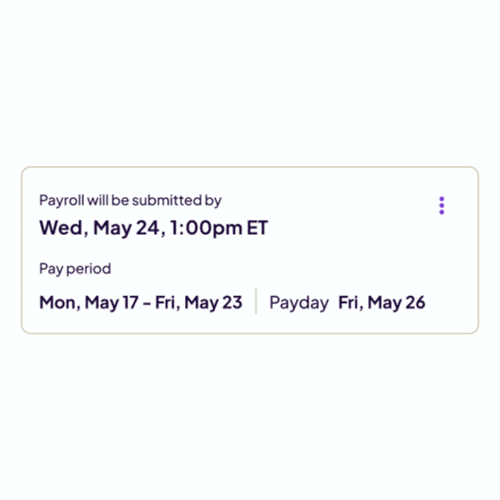Launched Q3, 2023 / Web / Lead designer
Homebase Autopayroll - helping business owners run payroll on time, every time
Homebase is platform providing a sleuth of tools to help SMBs’ success—one of which is Payroll.
Proactively identifying this problem at my other role, I prioritized this effort to be put on the roadmap. I gained buy-in across Ops, Sales, Product, Design, and leadership. As a result, our redesigned user journey had impressive outcomes:
37% users to self-serve setup, cut down time-to-task by 10x (10 days to 30 minutes), and a remarkable surge in operations bandwidth team from a team of 13 to 10.
Role
Product Designer
Timeline
2 months (Jun - Aug 23’)
Core responsibilities
Product strategy, Product design, User research
Problem
Business owners struggle running payroll on time, leading to extra customer support tickets, in addition to tax penalties and distrust from their team members
When a business owner submits payroll, it takes up to 4 days for their team members to get payments into their bank account.
We’ve found that 11% of the payroll runs 2023 were submitted late. There were 90,000 payroll runs—meaning more than 9000 payrolls weren’t submitted on time. Late payrolls happen despite Homebase providing various reminders via avenues on communication, such as text messages, push notifications, calls, and so on.
Requesting a sped up payroll processing time is of the top 5 reasons on our business owners submitting a customer service ticket.
Customer service tickets and emails that come through.
We have automatic reminders to let users know it’s time to run payroll
Supporting business owners by minimizing friction to run payroll, ultimately decreasing late payrolls and tax penalties
Autopayroll - a frictionless way for business owners to run payroll on time, every time
Letting users “leave payroll to us” depending on set pay date
Opting in experience
Upcoming reminders to gain business owners trust
Meeting our users where they were at, e.g. asking them whether they’ve paid their team before
Goals
Solution
Guided by generative feedback and feature requests, I spearheaded this effort and successfully got an approval from leadership. This effort and feature would lead to decreased support tickets, in addition to broadening our payroll feature set. In both cases, this helps increase revenue and company scalability.
The series of solutions made it so we could complete the user journey on what it looks like to “opt into Autopayroll”, ultimately providing a complete experience
1% payrolls run automatically, 2% overall customer service tickets decrease, % increase in ARR*, feature helped raise series D
Result
These outcomes were achieved after 6 months of work, with the final actual % milestone still pending.
Process / Research
Business owners are 5 minutes late on average to run payroll, and 4 out of 5 business users claim they “forgot”
In rounds of user research, sending out surveys to users, we’ve learned that business owners typically forget to run payroll. Users typically “swears they’ve remembered to run, but procrastinate into doing so”.
Business owners are late by 1 minute to 3 hours, with an average of 30 minutes.
The other most common case is the opposite; users purposely make late payments due to cashflow issues and money mismanagement.
True to our hypothesis, 6 out of 10 business owners don’t have corrections to payroll runs…take 3 minutes to run payroll on average
Partnering with data to parse data and UX events, we’ve learned that most commonly, a business owner’s lifecycle starts with checking time sheets and making sure they’re correct. They make corrections in their time sheets daily.
Once the pay period comes to a close, business owners “lock” their time sheets and start opening their payroll. When running payroll, we learned that users breeze through it—no double checking and no making corrections afterwards.
Process / Experiment
While “waitlist” experiment didn’t go as planned, working with Marketing helped us get stats that met metrics
Because this was a bigger feature, I needed to test out the waters by quickly experimenting on whether this feature piques our users’ interest. Though I didn’t get the results I anticipated by 2.6%, collaborating with Marketing and Sales helped us drive word of mouth, leading to the number we hoped for.
I also sought guidance from our content specialist for an A/B testing on content.
Process / Experiment
Image on the left had longer and less feature-descriptive copy, with non-committal CTA (waitlist). It got 2.3x conversion rate VS Image on the right.
Process / Ideation
Leading strategy plan, I explored ways on how we might introduce this feature to our business owner users
I got together and strategized a 3 prong action plan alongside Marketing, PR, Brand, and Sales to launch Autopayroll. The goal was to gather as much “hype” as we could, to push Autopayroll word of mouth.
Process / Validation
Process / Vision
Learning from Homebase users on the feature’s framing that boosts perceptions of this net new feature
Thinking ahead towards our vision of monetizing this feature, I launched 3 tests:
“What to call”, learning what to call this feature and how it’ll resonate with our users
“WTP” or “Willing to pay”, learning how much our users value this product
Pilot testing and rounds of iteration
Navigating towards the invisible tasks of running payroll: from tax filings, running bonus payroll, and so on
Our long term vision is to have payroll invisible to our users, so they can focus on what matters most: growing their business, supporting their team members, and ultimately making their dream a reality,
Process / Next steps
Only the beginning of our net new feature, our next steps is to scale this into monetization
Initiating this conversation with the monetization and growth team, I helped built strategy and generative research towards opportunity in maximizing value prop out of Autopayroll.
Providing a failsafe, in cases where users have non-sufficient funds
Meeting our users where they were at, e.g. asking them whether they’ve paid their team before









